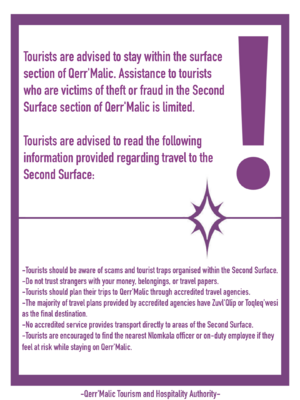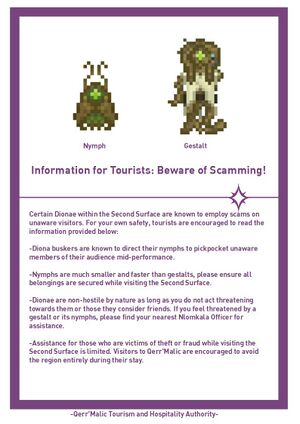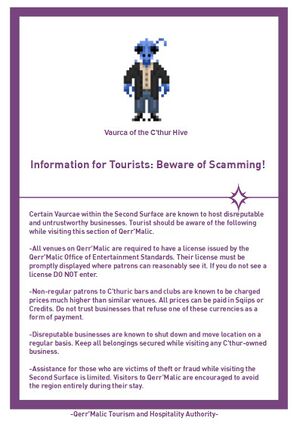Qerr'Malic
▶ This wiki page is currently behind the Phoron Scarcity update ◀
Information concerning phoron or the phoron scarcity may be outdated, lacking or unsatisfactory. Questions related to the phoron rework can be raised on Lore Discord.
| Skrell Lore Pages | ||
|---|---|---|
| Skrell | Skrell Biology · Skrell Relationships · Notable Skrell | |
| Planets, Systems, Settlements | Qerrbalak · Qerr'Malic · Aliose · Aweiji · Tattuqig · Xrim · Diulszi · Skrell Abroad · Notable Skrell Systems and Locations · Generation Fleets · The Prescient Republic of the Qar | |
| Organizations, Factions, Politics | Nralakk Federation · Skrell Politics · Skrell Enforcement · Federation Crime and Resistance · C'thur in the Federation · Dionae in the Federation | |
| Culture, Society, History | Skrell Culture · Skrell Cinema and Idols · Skrell Education · Skrell Technology · Skrell Cuisine · Skrell History · Skrell Beliefs · Skrell Mythology | |
| REGION - Homeworld | ||
|---|---|---|
| This location is centred in the Homeworld region. | ||
| The geographical and strategic centre of the Nralakk Federation, the Homeworld region encompasses the entirety of the Nralakk system, the origin point for the Skrell species. The region is considered the "jewel" of the Federation, being both the most affluent and most influential system of the nation, as well as housing almost a quarter of the Orion Spur's total Skrell. It has a single Bluespace gate, connecting the system to Humanity's Episilon Eridani.
Qerrbalak, Qerr'Malic, and Aliose are located in the Homeworld region. | ||
Qerr'Malic
Qerr’Malic is the moon of Qerrbalak, and was the first celestial body explored by skrell at the start of their space age. Since ancient history, Qerr'Malic was seen as a benevolent figure watching over the planet due to its influence over the tides, and has stayed a cultural fascination well into the modern day. Followers of both Qeblak and Weishii hold a reverence for the moon, especially within sects on Qerrbalak. Qerr’malic is roughly twice the size of Earth’s Luna, and is the sole moon of the planet. The lunar colonies are separated between surface installations and their underground infrastructure and maintenance areas, dubbed the Second Surface by those living there.
History
Qerr'Malic was a subject of focus during Qerrbalak’s ancient historical periods, with its presence in the night sky and tidal influence earning it the name Protector of the World. In the period of Qe'qlak being the dominant religion, Qerr'Malic was revered as a guardian created by Nralakk to protect Qerrbalak.
During the War of the Tides period in 1980 BCE, the first skrell-made surveillance probe landed on the surface of Qerr'Malic. This sparked a wave of further probes and scientific instruments sent by multiple factions to expand intelligence networks and participate in the space race. The few probes, drones, and satellites that survived remain on the surface as monuments to this part of skrell history.
Colonization efforts of the moon began after the first settlements within the crust of Aliose proved successful, though Qerr'Malic proved more difficult than Aliose due to its lack of atmosphere. Qerr’Malic’s colonies were originally intended to facilitate research and cultural fascination, but were quickly overturned at the discovery of rich mineral loads under the surface.
With Qerrbalak’s resource reserves exhausted by the time of this discovery, Qerr’Malic’s resource richness turned the colonies into rapidly expanding industrial centers. Soon, most of the colony’s population became extraction and industrial workers, expanding deeper into the moon’s subterranean surface. The Qerr'Malic Mining Consortium was established to manage the expansion of the colonies, and was primarily comprised of multiple Consultant Agencies. The mining consortium eventually formed the ruling body of Qerr’Malic’s colonies, with the establishment of the Commonwealth of the Three eventually absorbing it afterwards. Most of the moon’s colonists agitated for independence from the Commonwealth before moving to break ties, resulting in the original Consultant Agencies' reemerging to quash the independence effort after negotiations failed.
Qerr'Malic’s colonies eventually shifted away from resource extraction and industrial focuses as the moon’s resources waned in light of its expansion, instead switching towards operating as a port between trade and Qerrbalak’s logistics network. Tourism grew as the colonies catered towards the influx of off-world visitors, with 2002 CE considered the turning point of Qerr’Malic’s full shift towards catering to tourists. Most mines were developed into subterranean transportation networks, or repurposed into housing for the maintenance workers required to maintain the colony, forming the Second Surface. Little of the original surface settlements remain, with what remains being maintained as historical museums for tourists to visit.
Pre-Glorsh-Omega, Qerr’Malic hosted a large server farm which Glorsh used to access and communicate with other artificial intelligences within the Nralakk Federation’s networks. This server farm was destroyed in the initial attempt to stop Glorsh-Omega’s expansion, and the facilities that remain is classed as a heritage site, with cordons surrounding it to prevent development around it.
Government
During the rule of the Commonwealth of Three, Qerr’Malic was ruled by a Consultant Agency-based mining consortium, being essentially led and managed by corporations. With the formation of the second Nralakk Federation, Qerr’Malic was formally absorbed by the Federation’s political structure as a formally managed colony. Qerr'Malic only has two regions, consisting of the Surface Region and the Second Surface Region. Both regions are assigned governors, and are led by the Planetary Governor Aleq Val'monn since their placement in 2250 CE. Val’monn faces heavy criticism for their lack of action regarding the Gasriders on Qerr’Malic, with no current formal actions taken by Nralakk's System Councillor to replace them thus far.
Economy
Qerr’Malic’s economy originally functioned as an industrial powerhouse, with the moon’s rich mineral reserves providing for a resource-exhausted Qerrbalak and a growing production base. Once these reserves were completely tapped, the colonies transitioned to its position above Qerrbalak as an immense port, with the expansion of amenities for visitors to Qerr’Malic slowly changing the face of its surface cities from industrial towns to vacation locales. Modern Qerr’Malic advertises itself as the most popular and luxurious tourist destination in the Nralakk Federation, drawing an immense amount of tourists and vacationers throughout the year to its cities. Any remaining industries are sequestered into the Second Surface underground, and is otherwise primarily dependent on imports to keep the cities running.
Most income comes from Qerr’Malic’s immense service and hospitality industry, catering to the many vacationers and Primary Numericals who expect a luxury experience, and pay as much for it. Resorts, clubs, entertainment venues, and many other opportunities for patrons to entertain themselves make the bulk of most employment for local skrell, with maintenance and operational management relegated to vaurca and dionae within the Second Surface. Billions of credits flow into Qerr’Malic from the collective conspicuous spending of its clientele, with its functions as a trade port supporting the unending vacation on the moon.
Special Economic Zone
Toqleq'wesi hosts the Idris Incorporated-sponsored casino named MARE LAETATIO, which is a massive casino that hosts premiere services such as restaurants, lounge singers, gambling halls, and extravagant stage performances. Idris sponsors many human workers to staff the casino, though local skrell are readily hired as staff where possible.
NanoTrasen also has a presence on the Qerr’Malic, hosting server farms and infrastructure for the non-citizen extranet networks within the Nralakk system. The corporation has promised to import only small amounts of workers as specialists, instead hiring locals for unskilled labour as part of an agreement with the local Qerr’Malic Government.
Environment
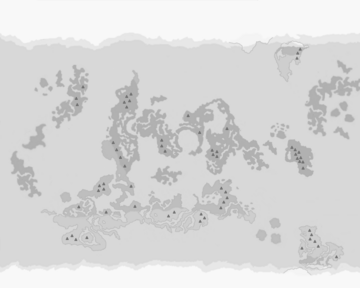
Qerr’Malic’s formation is the presumed result of two orbital bodies impacting each other during Qerrbalak’s earliest geological eon, and predominantly features craters across its surface. This early impact is the assumed source of the multiple prominent craters on Qerrbalak’s surface, with the "Collider Theory" based on similar mineral compositions between the moon and the surviving pieces found in the planet’s craters. While notably mineral-rich in its past, modern Qerr’Malic is considered completely exhausted of resources, featuring immense extraction sites and artificial caverns under its surface.
Qerr'Malic’s terrain is rocky and extreme, featuring immense impact basins, prominent faults, and deep ravines across the surface. Due to the difficulty of the surface, most large crevices were used to house the colonial facilities, before being expanded to extract and refine the moon’s resources. After the industrial downturn and pivot towards acting as a port and tourist destination, these underground areas were developed into the maintenance and transport facilities that make up the modern Second Surface. While interest in terraforming Qerr'Malic is sometimes expressed by the Federation, the lack of resources and atmosphere discourage official efforts and are diverted to the Federation's other sectors. Because of this, the surface settlements on Qerr’Malic consist solely of arcologies similar to New Gibson and Aliose.
With the integration of Hive C'thur’s vaurca into the Federation’s workforce, Qerr’Malic’s Second Surface expanded to house them as the new majority of maintenance workers. This influx saw the expansion of the underground transportation network, which now more readily ferries supplies to the surface colonies.
Seasons
Qerr’Malic lacks an atmosphere, and thus has no weather or seasons beyond its rotation. Seasons are instead simulated within the colonies themselves, mimicking Qerrbalak’s seasonal patterns and calendar. During the Qu-Paalq season, the humidity and temperature rise within the colonies, with the Lu-Paalq season cooling them. In the areas not designated as living spaces, the artificial atmosphere is kept at a constant, standard temperature and humidity for skrell to work in comfortably.
Cities and Landmarks
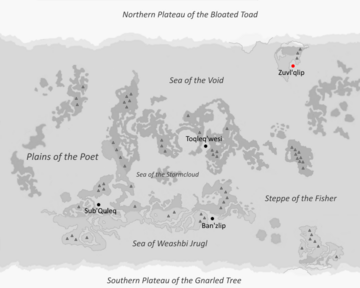
Zuvl'Qlip
Zuvl’Qlip is the capital and first colony of Qerr’Malic, and is located within the Sea of the Void atop its mountains on the eastern fringe. Zuvl’Qlip has the largest permanent population of the colonies, and maintains robust transport to the surrounding colonies via the Second Surface’s transport network despite its geographical isolation. Zuvl’Qlip is also the location for Qerr’Malic’s primary spaceport, making it the first destination for most arriving tourists.
While not the primary destination for visitors, the capital still offers many entertainment venues on the historical and cultural significance of Qerr’Malic. The most popular of these is the Explorers' Museum, which is part of the Nralakk Federation’s Archive Project. The Explorers’ Museum features the most cultural artifacts and historical objects of the species, and showcases artifacts from Qerr’Malic’s initial colonization, archaeological samples, and diaries of the first colonists. The Explorers' Museum also provides high-class facilities that provide authentic skrell cuisine and cinematography.
Sub'Quleq
Sub'Quleq, or Settler's Paradise in Basic, is located in the Second Surface as the primary living space for non-skrell workers on the Qerr’Malic. The city primarily houses C'thur workers and sizable Diona communities. Settler's Paradise is considered an infamous host to most illegal activity and less respectable entertainment venues on Qerr’Malic.
C’thur hive cells are regularly suspected of managing criminal gambling dens, being accused of being rigged against clientele. Most bars and clubs in the city are run by local hive cells, although some are considered suspect of price-gouging tourists. Dionae taking part in the city’s underground entertainment industry are usually buskers and grifters. Dionae use their ability of audio-mimicry and detach nymphs to become stage or street performers. Tourists visiting Sub’Quleq will commonly see diona singers in clubs or on sidewalks, using their mimicry to perform popular songs, with grifters distracting their audience with dazzling performances while other nymphs steal from them.
Despite Sub’Quleq being a hotbed for illegal activity, most efforts to curb them fail. Most gambling dens are temporary establishments and readily disappear within days, often migrating to service other locations. Most local hive cells’ Ta-caste members cooperate closely with Kala authorities to halt other illegal fronts, notably stopping illegal k’ois farms. Tourists are discouraged from visiting Sub’Quleq, with multiple tourism guides and public areas hosting public warnings about visits to the city. Despite this, Sub'Quleq still a popular location for slum tourism due to its reputation and access to less respectable and obscene entertainment options. The authorities on Qerr’Malic are seen as notoriously unhelpful with reports from Sub’Quleq’s tourists, seeing them as having accepted the risks beforehand.
Examples of posters issued by the Qerr'Malic Tourism and Hospitality Authority warning tourists against visiting the Second Surface.
Toqleq'wesi
Toqleq’wesi is the second-largest city on Qerr’Malic, located within the deepest trench in the Sea of the Stormcloud. Toqleq’wesi is the entertainment capital of the moon, with the majority of tourists making it their sole destination. The city advertises itself as the entertainment capital of the entire Nralakk Federation both domestically and internationally, with advertisements for trips to Qerr’Malic focusing on it entirely. Advertisements for discounted trips to Qerr’Malic on Viv-ID or the extranet are very common, prominently displayed as the number one tourist destination of the Federation.
Toqleq’wesi’s formation started in a tectonically unstable section of the Sea of the Stormcloud, which unearthed a geothermal vent to an exotic gas found solely on Qerr’Malic. This gas was dubbed ‘Xu’xi Gas’, with inhalation causing intoxicating effects on the user.
Ban'zlip
Ban’zlip is the remains of the server farm that Glorsh-Omega used to assume control of all synthetics and other artificial intelligences within the Nralakk Federation. This facility is roughly two hundred square kilometers in total size, and is kept well-maintained by a permanent group of resident maintenance crews. Most of Ban’zlip is closed to the public due to safety concerns, with shuttlecraft used to provide tours of safer sections. The ruin is designated as a heritage site, preventing any attempts of expansion near it or otherwise disrupting it. Small, designated archaeological projects are underway in an attempt to recover pre-Glorsh data that might still be housed in the remaining intact servers.
Holidays
- Founding Day - Celebrated in the middle of Avroxi-qog, Founding Day on Qerr’Malic is a celebration of the shift in 2002 CE, with the colonies being redesignated from a mining colony to one of tourism. Because Qerr’Malic is specialized in its service economy, Founding Day celebrations are staggered based on the typical work shift: fireworks displays and other public events take place at 4 AM for night shift workers, and again at 7 PM for day shift workers. This allows the locals to take part in the festivities without necessitating time off to celebrate. Qerr’Malic has since evolved the holiday to include tourists, with many venues becoming themed on mining or astronauts, referencing the colony’s early history and the initial moonwalks that took place early in the space age.
- Qerr’paq’uu - Celebrated during the transition from Qu-Paalq to Lu-Paalq, Qerr’paq’uu celebrates the cultural and religious significance that Qerr’Malic has within skrell culture and Qerrbalak. Considered fairly tame, the holiday has no officially observed festivities, instead primarily celebrated in local communities. Stargazing nights, street parties, potlucks, and other locally organized events are common. Qeblak and Weishii followers will typically schedule coming of age ceremonies coincide with Qerr’paq’uu, believing it to bring them luck.
Demographics
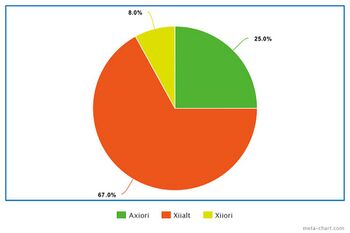
As Qerr’Malic lacks any natural bodies of water, Axiori skrell are relatively uncommon both on the surface and Second Surface regions. Most skrell are Xiialt, with smaller communities of Xiiori skrell. The majority of non-skrell Qerr’Malic live in the Second Surface region, mostly consisting of C’thur vaurcae. The smallest non-skrell group on Qerr’Malic are dionae, who also live and work in the Second Surface. Qerr’Malic’s tourist populace fluctuates on the season, but regularly stays at nearly 4% of the current population.
There are a small number of humans that work on Qerr’Malic, specifically within the designated special economic zone, and are employed by Idris and NanoTrasen.
Percentages
Skrell
Skrell make up roughly 70% of Qerr’Malic’s total permanent population. The percentages below are of the skrell population:
- Axiori - 25%
- Xiialt - 67%
- Xiiori - 8%
Non-Skrell
Non-skrell on Qerr’Malic make up the other 30% of the moon’s population, not including tourists. The percentages below are of the non-skrell population:
- C’thur Vaurca - 87%
- Dionae - 12%
- Human - <1%
Culture and Life on Qerr'Malic
Qerr’Malic has a distinct cultural divide between the surface and the Second Surface. The surface metropolises of Toqleq’wesi and Zuvl’Qlip are bustling metropolises and primarily exist as places of luxury. Surface cities provide high quality commodities, places to dine, shop, and almost every form of entertainment. Visitors to Qerr’Malic expect the level of quality that comes with the moon’s public image, coupled with heavy Qekala presence to reassure tourists of their safety while they spend their vacation under the domes. Almost all local skrell workers live on the surface, residing inside habitats connecting to the larger cities through the subsurface trams. Qerr’Malic locals living on the surface are perceived as more sociable, due to their work training regarding maintaining positive appearances while working with tourists.
In contrast, the Second Surface is a network of transport stations, utility stations, storage facilities, and living quarters to support the surface. The Second Surface has its foundations in redeveloped mining complexes from Qerr’Malic’s past, with most old infrastructure repurposed to provide a robust support network for the entire moon. Closer to the true surface are tram stations, warehouses, and utility stations controlling power, atmosphere, and heating systems for the colonies. Further subterranean structures consist of habitat sections for Qerr’Malic’s non-skrell workers to live, with the C’thur vaurcae its primary inhabitants. The environment of the Second Surface is comfortable for vaurca, who are adapted to living in vast underground complexes, though most dionae residents find it stressful. A lack of natural light, and their reliance on artificial light sources to sustain themselves, leaves most dionae residents in a state of constant anxiety. Qerr’Malic dionae have adapted to forming larger communities, finding safety in numbers in the cities within the Second Surface like Sub’Quleq, where the fear of losing light sources is reduced. Inhabitants of the Second Surface are usually more industrious due to their importance in maintaining the surface colonies, and have developed more insular communities as a result.
Skrell who end up falling below the Secondary Numerical category in the Social Compatibility Index system, or are legal fugitives, regularly flee to the Second Surface. The labyrinthine complexes are preferred places to hide from the law, which has since become a refuge for Qerr’Malic’s Gasriders, who work in the manufacture, smuggling, and sale of refined Xu’xi gas native to the moon.
Skrell from Qerr’Malic will typically be from a service and hospitality background, with most employed in the surface cities. Qekala presence on Qerr’Malic is notably denser due to the moon’s popularity as a tourist destination, with more enforcers stationed there as foreign tourism rises in popularity. Surface employees are regularly trained to be friendly and approachable regardless of their position, due to their constant interaction with tourists. Due to their customer-friendly disposition, most skrell from Qerr’Malic readily find work opportunities abroad with corporations like Idris Incorporated, which emphasizes consumer friendliness in its service and security branches. Vaurca and dionae regularly find work in engineering or mining careers, though some vaurca virtual reality specialists do find employment in their specializations. Most specialists maintain and operate the sophisticated VR centers found in some sections of the surface cities' venues. VR specialists that leave Qerr’Malic with their hive cell will typically transfer careers towards tech support or network maintenance.
Gasriders
Gasriders refer to those who participate in the production and selling of Xu’xi gas. Xu’xi gas is a naturally occurring substance produced in the geothermal vents of Qerr’Malic, and in small quantities give the user a mild high, comparable Wulumunusha. While the natural gas itself is not illegal, with vape bars built around vents being a common sight within Toqleq’wesi where the gas was originally located, the refinement and sale of Xu’xi gas is illegal due to refining methods creating a stronger, highly addictive narcotic.
Gasrider operations are limited to the deeper, remote areas of the Second Surface, away from authorities who are unable to readily search the immense network of tunnels and warehouses. Xu’Xi gas is smuggled out of Toqleq’wesi before being refined in large quantities, then smuggled back to the surface for sale to locals and tourists alike by dealers. Refined Xu’xi gas is also sold in bulk to the less-reputable establishments found on Qerr’Malic, such as the C’thur gambling dens of Sub’Quleq, or to smugglers who ship the gas off-world to other planets within the Nralakk Federation, or outside of the Federation entirely to other markets, such as Mendell City’s Starlight Zone.
The Gasriders beyond Qerr’Malic also produce synthetic alternatives to Xu’xi gas, with a similar high, but is coupled with stronger hangovers and potential lethality depending on the purity. Despite the Federation’s efforts, as well as resistance in local skrell communities in the Republic of Biesel and Sol Alliance, neither are successful in curbing the expansion of the Gasriders’ operations. This has been attributed to the inactivity of Qerr’Malic’s Planetary Governor, Aleq Val'monn, whose detractors claim is secretly benefitting from the operations on the moon. These claims remain unproven, but Governor Val’monn remains pressured from the public, as well as their superiors, to take an active effort against them.
See Related Page: Typical Skrell Slang
The Bureau of Void Technologies
The Bureau of Void Technologies (Quqaa-Lu’piq) is a government organization tasked with studying and procuring Glorsh-era technology, with the intent to reverse-engineer them and keep them out of the hands of anti-Federation agents. Headquartered on Zuvl'Qlip, the Bureau’s sprawling facilities are designed to minimize the potential harm caused by reactivating Glorsh-era technology. Scientists of the Quqaa-Lu’piq often specialize in anomalistics, engineering, biological, and medical fields. Founded in 2396, the Bureau formed as a response to the growing concerns over the reliance on Glorsh-era technology, which serves as an irreplaceable backbone to many Federation industries.
The Quqaa-Lu’piq is most well known in the Federation Core for the Museum of the Abyssal Age (Qeriqau-Lu’Xaqii), also colloquially known as the Museum of Ink. The Museum is dedicated to the history of the Glorsh-era skrell and the atrocities committed by the synthetic mind. The many exhibits include actual Glorsh-produced observation devices, X’Lu’oa syringes, wiped server racks, deadly combat synthetics, and scale models of the prisons and homes that housed millions of skrell during the period. Stations around the exhibits use psionic feedback technology and optional psionically active “tabs,” like those used in concerts, to project lesser versions of survivors' emotions directly into visitors' brains.
Outside of the core, the Bureau is known for its bounty system that it uses to officially sanction independent scavengers in the Traverse to collect Glorsh-era technology on its behalf. Federation politicians criticize the bounty system for putting citizens in harm's way, though many Coreworld-dwelling skrell see it as a necessary, albeit distasteful, practice. By Traversers, however, it is seen as a source of gainful employment, with many out-of-work spacers, miners, and low Index-scoring individuals flocking to help the Bureau uncover the next haul of long-lost technology. Rewards for those who survive excursions into deep space and uncover Glorsh-era technology include credit payouts and an increase to their Index score, making it an appealing profession for those looking for social mobility. The only exception to this bounty system is the Tri-Qyu system, which is strictly off-limits to all non-government personnel due to its connection to Glorsh-Omega.








